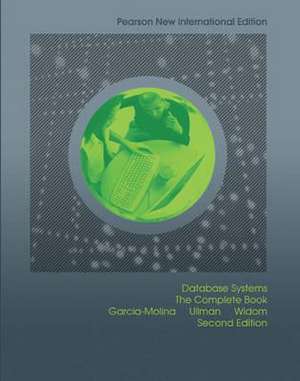Database Systems: The Complete Book
Autor Hector Garcia-Molina, Jeffrey Ullman, Jennifer Widomen Limba Engleză Paperback – 24 iul 2013
Preț: 593.20 lei
Preț vechi: 681.84 lei
-13% Nou
Puncte Express: 890
Preț estimativ în valută:
113.52€ • 117.28$ • 94.48£
113.52€ • 117.28$ • 94.48£
Carte disponibilă
Livrare economică 05-19 martie
Livrare express 18-22 februarie pentru 107.11 lei
Preluare comenzi: 021 569.72.76
Specificații
ISBN-13: 9781292024479
ISBN-10: 129202447X
Pagini: 1140
Ilustrații: illustrations
Dimensiuni: 220 x 275 x 90 mm
Greutate: 2.77 kg
Ediția:2. Auflage
Editura: Pearson Education
ISBN-10: 129202447X
Pagini: 1140
Ilustrații: illustrations
Dimensiuni: 220 x 275 x 90 mm
Greutate: 2.77 kg
Ediția:2. Auflage
Editura: Pearson Education
Cuprins
TABLE OF CONTENTS
1 The Worlds of Database Systems
1.1 The Evolution of Database Systems
1.1.1 Early Database Management Systems
1.1.2 Relational Database Systems
1.1.3 Smaller and Smaller Systems
1.1.4 Bigger and Bigger Systems
1.1.5 Information Integration
1.2 Overview of a Database Management System
1.2.1 Data-Definition Language Commands
1.2.2 Overview of Query Processing
1.2.3 Storage and Buffer Management
1.2.4 Transaction Processing
1.2.5 The Query Processor
1.3 Outline of Database-System Studies
1.4 References for Chapter 1
PART I: Relational Database Modeling
2 The Relational Model of Data
2.1 An Overview of Data Models
2.1.1 What is a Data Model?
2.1.2 Important Data Models
2.1.3 The Relational Model in Brief
2.1.4 The Semistructured Model in Brief
2.1.5 Other Data Models
2.1.6 Comparison of Modeling Approaches
2.2 Basics of the Relational Model
2.2.1 Attributes
2.2.2 Schemas
2.2.3 Tuples
2.2.4 Domains
2.2.5 Equivalent Representations of a Relation
2.2.6 Relation Instances
2.2.7 Keys of Relations
2.2.8 An Example Database Schema
2.2.9 Exercises for Section 2.2
2.3 Defining a Relation Schema in SQL
2.3.1 Relations in SQL
2.3.2 Data Types
2.3.3 Simple Table Declarations
2.3.4 Modifying Relation Schemas
2.3.5 Default Values
2.3.6 Declaring Keys
2.3.7 Exercises for Section 2.3
2.4 An Algebraic Query Language
2.4.1 Why Do We Need a Special Query Language?
2.4.2 What is an Algebra?
2.4.3 Overview of Relational Algebra
2.4.4 Set Operations on Relations
2.4.5 Projection
2.4.6 Selection
2.4.7 Cartesian Product
2.4.8 Natural Joins
2.4.9 Theta-Joins
2.4.10 Combining Operations to Form Queries
2.4.11 Naming and Renaming
2.4.12 Relationships Among Operations
2.4.13 A Linear Notation for Algebraic Expressions
2.4.14 Exercises for Section 2.4
2.5 Constraints on Relations
2.5.1 Relational Algebra as a Constraint Language
2.5.2 Referential Integrity Constraints
2.5.3 Key Constraints
2.5.4 Additional Constraint Examples
2.5.5 Exercises for Section 2.5
2.6 Summary of Chapter 2
2.7 References for Chapter 2
3 Design Theory for Relational Databases
3.1 Functional Dependencies
3.1.1 Definition of Functional Dependency
3.1.2 Keys of Relations
3.1.3 Superkeys
3.1.4 Exercises for Section 3.1
3.2 Rules About Functional Dependencies
3.2.1 Reasoning About Functional Dependencies
3.2.2 The Splitting/Combining Rule
3.2.3 Trivial Functional Dependencies
3.2.4 Computing the Closure of Attributes
3.2.5 Why the Closure Algorithm Works
3.2.6 The Transitive Rule
3.2.7 Closing Sets of Function
1 The Worlds of Database Systems
1.1 The Evolution of Database Systems
1.1.1 Early Database Management Systems
1.1.2 Relational Database Systems
1.1.3 Smaller and Smaller Systems
1.1.4 Bigger and Bigger Systems
1.1.5 Information Integration
1.2 Overview of a Database Management System
1.2.1 Data-Definition Language Commands
1.2.2 Overview of Query Processing
1.2.3 Storage and Buffer Management
1.2.4 Transaction Processing
1.2.5 The Query Processor
1.3 Outline of Database-System Studies
1.4 References for Chapter 1
PART I: Relational Database Modeling
2 The Relational Model of Data
2.1 An Overview of Data Models
2.1.1 What is a Data Model?
2.1.2 Important Data Models
2.1.3 The Relational Model in Brief
2.1.4 The Semistructured Model in Brief
2.1.5 Other Data Models
2.1.6 Comparison of Modeling Approaches
2.2 Basics of the Relational Model
2.2.1 Attributes
2.2.2 Schemas
2.2.3 Tuples
2.2.4 Domains
2.2.5 Equivalent Representations of a Relation
2.2.6 Relation Instances
2.2.7 Keys of Relations
2.2.8 An Example Database Schema
2.2.9 Exercises for Section 2.2
2.3 Defining a Relation Schema in SQL
2.3.1 Relations in SQL
2.3.2 Data Types
2.3.3 Simple Table Declarations
2.3.4 Modifying Relation Schemas
2.3.5 Default Values
2.3.6 Declaring Keys
2.3.7 Exercises for Section 2.3
2.4 An Algebraic Query Language
2.4.1 Why Do We Need a Special Query Language?
2.4.2 What is an Algebra?
2.4.3 Overview of Relational Algebra
2.4.4 Set Operations on Relations
2.4.5 Projection
2.4.6 Selection
2.4.7 Cartesian Product
2.4.8 Natural Joins
2.4.9 Theta-Joins
2.4.10 Combining Operations to Form Queries
2.4.11 Naming and Renaming
2.4.12 Relationships Among Operations
2.4.13 A Linear Notation for Algebraic Expressions
2.4.14 Exercises for Section 2.4
2.5 Constraints on Relations
2.5.1 Relational Algebra as a Constraint Language
2.5.2 Referential Integrity Constraints
2.5.3 Key Constraints
2.5.4 Additional Constraint Examples
2.5.5 Exercises for Section 2.5
2.6 Summary of Chapter 2
2.7 References for Chapter 2
3 Design Theory for Relational Databases
3.1 Functional Dependencies
3.1.1 Definition of Functional Dependency
3.1.2 Keys of Relations
3.1.3 Superkeys
3.1.4 Exercises for Section 3.1
3.2 Rules About Functional Dependencies
3.2.1 Reasoning About Functional Dependencies
3.2.2 The Splitting/Combining Rule
3.2.3 Trivial Functional Dependencies
3.2.4 Computing the Closure of Attributes
3.2.5 Why the Closure Algorithm Works
3.2.6 The Transitive Rule
3.2.7 Closing Sets of Function
Notă biografică
Hector Garcia-Molina is the L. Bosack and S. Lerner Professor of Computer Science and Electrical Engineering at Stanford University. His research interests include digital libraries, information integration, and database applications on the Internet. He was a recipient of the SIGMOD Innovations Award and a member of PITAC (President's Information-Technology Advisory Council). He currently serves on the Board of Directors of Oracle Corp. Jeffrey D. Ullman is the Stanford W. Ascherman Professor of Computer Science (emeritus) at Stanford University. He is the author or co-author of 16 books, including Elements of ML Programming. His research interests include data mining, information integration, and electronic education. He is a member of the National Academy of Engineering, and recipient of a Guggenheim Fellowship, the Karl V. Karlstom Outstanding Educator Award, the SIGMOD Contributions and Edgar F. Codd Innovations Awards, and the Knuth Prize.
Jennifer Widom is Professor of Computer Science and Electrical Engineering at Stanford University. Her research interests span many aspects of nontraditional data management. She is an ACM Fellow and a member of the National Academy of Engineering, she received the ACM SIGMOD Edgar F. Codd Innovations award in 2007 and was a Guggenheim Fellow in 2000, and she has served on a variety of program committees, advisory boards, and editorial boards.
Jennifer Widom is Professor of Computer Science and Electrical Engineering at Stanford University. Her research interests span many aspects of nontraditional data management. She is an ACM Fellow and a member of the National Academy of Engineering, she received the ACM SIGMOD Edgar F. Codd Innovations award in 2007 and was a Guggenheim Fellow in 2000, and she has served on a variety of program committees, advisory boards, and editorial boards.
















